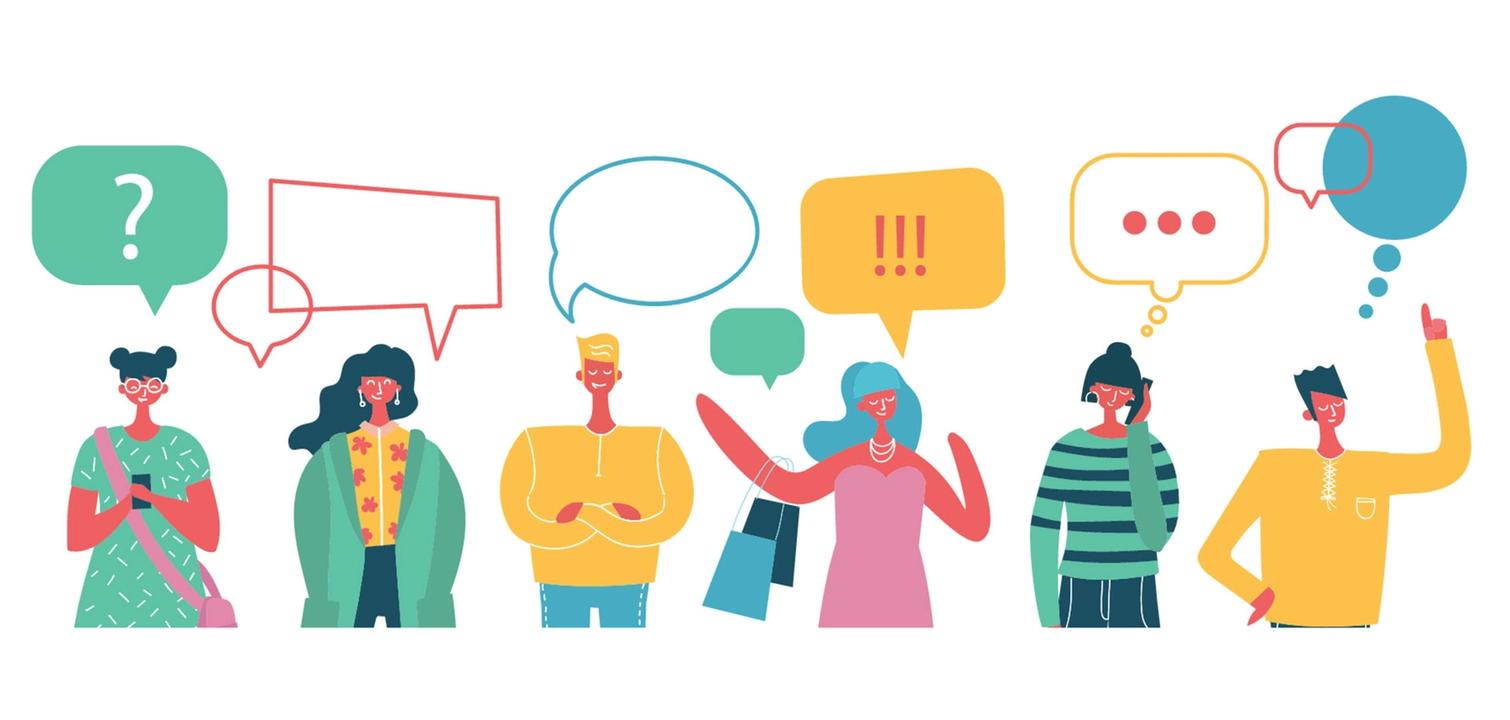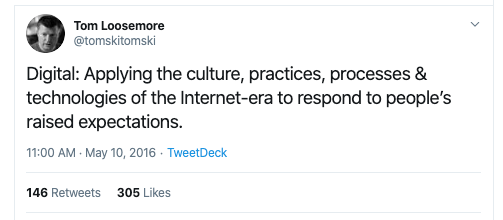What does digital engagement mean?

This article was written in collaboration with Matt Saunders from Charitybox. His book, The Digital Charity is available in paperback now.
According to the 2019 Charity Digital Skills report, digital strategy is an area of increasing concern for charities of all sizes. The brilliant Madeleine Sugden has tackled that issue head-on in her blog. It’s important to realise that digital is a part of everything we do now: from Facebook groups to digital services. It’s unavoidable and integral to every aspect of our work.
One of the lingering questions is what digital means in a very practical sense – especially digital engagement. A digital strategy should be underpinned by clear definitions of what engagement means for fundraising, marketing and communications teams.
In reality, digital is an underlying current of everything we do on a daily basis.
The big change in our work as professionals in the third sector are the expectations of our users. I’m not only talking about our supporters and the people who use our services but those that don’t even know we exist yet. The people we need to bring through our doors (at least metaphorically speaking), to use our service, grow our income or build our brand. In reality, digital is an underlying current of everything we do on a daily basis.

What does digital mean for your organisation? Maybe, just maybe, it’s everything.
Defining digital
With that in mind I’d like to tackle that question of what “digital” means for engagement and offer an easy definition:
Digital engagement is anything and everything that involves an online conversation
This definition is from Tim Lloyd the former Deputy Head of Digital at the Department of Health. It has aged incredibly well and still rings true for charities tackling digital today. We’re having a lot of online conversations and most of them aren’t using our voices. The graphic below goes some way to explain the different touchpoints.

Does your strategy cover all of these touchpoints? Which one are you missing?
Let’s break down these touchpoints and see which ones you might be missing. They might all be linked, but each one has different properties and different expectations, and some might not be relevant to your organisation at all.
Marketing & fundraising
Oh boy – this is the big one. From digital fundraising platforms and social media channels to newsletters and emails, this category covers a lot of touchpoints and a lot of different engagement strategies. The golden rule here is to treat each “channel” or communication method as a separate bubble. Maybe use this graphic as a template for mapping out your digital engagement touchpoints. It might help you focus on the channels that need extra love.
The golden rule here is to treat each “channel” or communication method as a separate bubble.
You could argue it also covers your website, but I’ve broken that out into a separate category because it has other implications…
Managing your website
Your website is often the problem child of your organisation. Sometimes we struggle to admit that internally, but it normally holds true. Regardless of your size and your budgets, there is always something we want to improve on our website. That’s a good mindset. The reason I’ve broken this out into a separate bubble is that, unlike the others, the website is often (or should be) the end goal of a lot of digital engagement strategies. We should be driving people to our website wherever possible to convert them into donors, supporters, activists or fans. The website is not just the shopfront, it’s the whole storeroom of your organisation online – it’s how your people will interact with your services, educate themselves on what you do and get involved in your mission.
We should be driving people to our website wherever possible to convert them into donors, supporters, activists or fans.
With that in mind, there are implications for digital engagement when we look at our website – what is the user experience (or UX), what does this mean for people visiting the website (is it hard or difficult to navigate, for example), and what do you want people to do when they arrive. I can’t stress the importance of website analytics here – proving the ROI of your investment is vital to continued success. As Matt Saunders notes in his book The Digital Charity “Once you begin to understand which of your activities produce the best outcomes, you can be much more savvy with the way you spend your time and money”
Once you begin to understand which of your activities produce the best outcomes, you can be much more savvy with the way you spend your time and money
Supporter care
Looking after your supporters is the bread and butter of all good fundraising roles. It’s this relationship management that unlocks additional giving, volunteering or activism. A lot of your supporter care, you might think, is fairly analogue. You might spend a lot of time on the phone or in-person. But how much of that has shifted online? Perhaps you run a Facebook Group that’s full of your fundraising ambassadors or marathon enthusiasts. Maybe you send emails to your supporters (I hope you do!), or maybe you’re messaging them on Facebook after they set up a fundraiser for you. Maybe, just maybe, you have a chatbot on your website that helps to triage your service users. All of these things are digital engagement. Are you delivering quality, personalised conversations or are they letting you down?
A lot of your supporter care, you might think, is fairly analogue.
Campaigning and lobbying
Whatever your mission statement, at some point your organisation has done some campaigning or lobbying. Even local sports clubs would have engaged in some kind of low-level campaigning – fighting for their pitch or asking for new floodlights. For some organisations, like Amnesty International, campaigning and lobbying are your lifeblood. Maybe you’re a human-rights organisation that is campaigning for structural change within multi-national governments. Or maybe you’re a meningitis charity campaigning for affordable access to a new vaccine. Either way, a lot of these interactions are now considered digital engagement – as you drive more people towards petitions or as you share more infographics, you’re starting conversations online and it’s important to remember the person at the other end of that content and what they think, feel and do when they engage with you.
As you drive more people towards petitions or as you share more infographics, you’re starting conversations online
Internal communications
Possibly the most important but the least prioritised aspect of digital engagement for charities is how you engage your own employees, the board of trustees and volunteers. Maybe you’re a national cancer charity with an intranet (that’s an internal internet) or maybe you send employee news blasts over Slack or Facebook Workplace. This is digital engagement. It’s a conversation, albeit an internal one, that allows you to leverage best practice internally (and literally practice what you preach!
The least prioritised aspect of digital engagement for charities is how you engage your own employees
The next generation of digital learning

At Lightful, we’re working hard on developing the next generation of digital learning through our BRIDGE programme. The BRIDGE programme (Building resilience in digital growth and engagement) is our 12-month programme of live and self-paced e-learning content that is the bedrock of digital engagement for charities; from social media and website to email marketing and SEO.
To find out more about the BRIDGE programme take a look at the link below.
BRIDGE
Latest articles

In a world of growing uncertainty, small and local non-profit organisations often find themselves with competing priorities and struggle to plan how to allocate their available resources. Despite the increasing demand for their vital work, they are not always able to allocate the funds they receive to strategic planning and future growth.

As the world becomes more digitally-focused, it’s essential for nonprofits to have a digital presence. With more and more options for online engagement, we know that this can be challenging for nonprofits to tackle. But, we also know that it is a huge opportunity to increase audience engagement, awareness and fundraising. To help nonprofits navigate this, we’re going to explore the “whys” and “hows” of creating a nonprofit digital strategy. We’re even providing a free digital strategy canvas to help nonprofits improve their online presence in just a few steps.
Related posts

As the world becomes more digitally-focused, it’s essential for nonprofits to have a digital presence. With more and more options for online engagement, we know that this can be challenging for nonprofits to tackle. But, we also know that it is a huge opportunity to increase audience engagement, awareness and fundraising. To help nonprofits navigate this, we’re going to explore the “whys” and “hows” of creating a nonprofit digital strategy. We’re even providing a free digital strategy canvas to help nonprofits improve their online presence in just a few steps.

We’ve been hearing a lot about the metaverse lately and nonprofits that we work with are wondering what the emerging technology means to them. It’s difficult to get your head around something so new and different so we wanted to try to dig into it to understand more.
See who we help
Contact us
Want to learn more?
Email Jonathan and start a conversation





